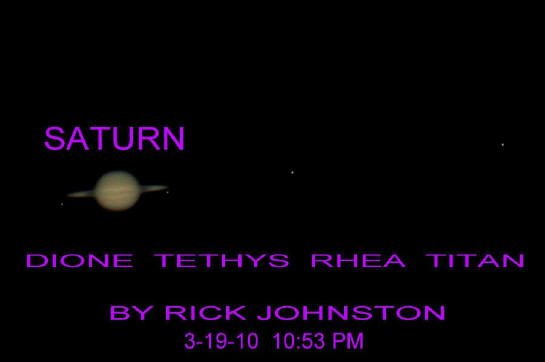For April 2010, the Moon will be new on April 3rd, the same day Saturn is at opposition as the only planet in the evening sky currently. The crescent moon is two degrees south of the fine Pleiades star cluster for Yuriís Night on April 9th. Earthshine lighting the dark upper part of the crescent should be a fine sight in binoculars as well
this evening. The first quarter moon sits overhead on April 11th. The waxing gibbous moon passes seven degrees south of Saturn in the east on April 17th. The Full Moon, the Egg Moon, falls on April 18th. The moon is last quarter on April 25, and the waning crescent moon passes by Venus on the last morning of the month.
Venus is low in the east just before sunrise, and will vanish behind the sun next month. Mercury, Mars, and Jupiter will join Venus in the morning sky at the very end of April, but all are too close to the Sun now to see Saturn is in the east in Virgo, just northwest of bright Spica, rising at sunset on April 3rd. This is the best time to
observe the most beautiful object in the sky. When viewed with a telescope, the rings are open 11 degrees, and Titan and several smaller moons fall on either side of the most beautiful telescopic sight in the sky. In addition to its glorious rings, Saturn hosts a huge moon, Titan, visible in most any telescope, and several smaller ones needing at least a 6" scope
to spot. Our attached image shows four of them, in line with the rings. This year, the north pole of Saturn is tilted slightly more sunward, and the rings will be a little more open and thus brighter; they will be at their best in 2017, Saturnís summer solstice, when they will double the planetís brightness.

Yellow Capella, a giant star the same temperature and color as our much smaller Sun, dominates the northwestern sky. It is part of the pentagon on stars making up Auriga, the Charioteer (think Ben Hur). Several nice binocular Messier open clusters are found in the winter milky way here. East of Auriga, the twins, Castor and Pollux highlight
the Gemini. South of Gemini, Orion is the most familiar winter constellation, dominating the southern sky at dusk.
The reddish supergiant Betelguese marks his eastern shoulder, while blue-white supergiant Rigel stands opposite on his west knee. Just south of the belt, hanging like a sword downward, is M-42, the Great Nebula of Orion, an outstanding binocular and telescopic stellar nursery. The bright diamond of four stars that light it up are the
trapezium cluster, one of the finest sights in a telescope. In the east are the hunterís two faithful companions, Canis major and minor. Procyon is the bright star in the little dog, and rises minutes before Sirius, the brightest star in the sky. Sirius dominates the SE sky as darkness falls. At 8 light years distance, Sirius is the closest star we can easily see
with the naked eye from West Florida.
To the northeast, look for the Big Dipper rising, with the top two stars of the bowl, the pointers, giving you a line to find Polaris, the Pole Star. Look for Mizar-Alcor, a nice naked eye double star, in the bend of the big dipperís handle. Take the pointers at the front of the dipperís bowl south instead to the head of Leo, looking much
like the profile of the famed Sphinx. The bright star at the Lionís heart is Regulus, the "regal star", but brighter still is Saturn, just east of Regulus.
Now take the curved handle of the Big Dipper, and follow the arc SE to bright orange Arcturus, the brightest star of the spring sky. Recent studies of its motion link it to the Sagittarius Dwarf Galaxy, a companion of our Milky Way being tidally disrupted and spilling its stars above and below the plane of the Milky Way, much like dust
falling away from a decomposing comet nucleus. So this brightest star of Bootes the Bear Driver is apparently a refugee from another galaxy!
Now spike south to Spica, the blue-white gem in Virgo rising in the SE. Virgo is home to many galaxies, as we look away from the obscuring gas and dust in the plane of the Milky Way into deep space. To the southwest of Spica is the four sided Crow, Corvus. To the ancient Greeks, Spica was associated with Persephone, daughter of Ceres,
goddess of the harvest. She was abducted by her suitor Pluto, carried down to Hades (going to Hell for a honeymoon!) and when Jupiter worked out a compromise between the newlyweds and the angry mother-in-law, the agreement dictated Persephone come back to the earthís surface for six months of the year, and Mama Ceres was again placated, and the crops could grow
again.
As you see Spica rising in the SE, it is time to "plant your peas", and six months from now, when Spica again disappears in the sunís glare in the SW, you need to "get your corn in the crib"Ö.so was set our calendar of planting and harvesting in antiquity. In the arms of Virgo is a rich harvest of galaxies for modern astronomers; the Virgo
supercluster lies about 50-60 million light years distant, and contains over a thousand galaxies, many larger than our own Milky Way.